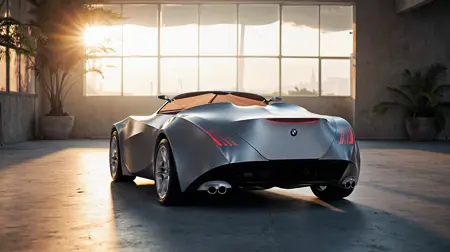BMW GINA Concept - 2008
Details
Download Files
About this version
Model description
Skin Deep: Deconstructing the Philosophy, Technology, and Enduring Legacy of the 2008 BMW GINA Light Visionary Model
The 2008 BMW GINA Light Visionary Model stands as one of the most radical and philosophically ambitious concept cars of the 21st century. More than a mere design study, GINA was a rolling thesis that questioned the fundamental dogmas of automotive construction. Spearheaded by then-BMW Group Design Chief Chris Bangle, the project was the ultimate expression of his "context over dogma" philosophy, which prioritized flexible thinking over the rigid rules that had long governed the industry. Its name, an acronym for "Geometry and Functions In 'N' Adaptations," signified a commitment to infinite possibilities and a more emotional, human-centric relationship between driver and vehicle.
At its core, GINA deconstructed the automobile by replacing conventional rigid body panels with a seamless, flexible fabric skin stretched over a kinetic substructure. The skin itself was a bespoke, polyurethane-coated Spandex hybrid textile, engineered to be exceptionally durable, water-repellent, and resistant to temperature changes and expansion. This material was stretched over a lightweight aluminum space frame, which was augmented with a network of metal wires and flexible carbon fiber struts. This underlying frame was not static; it was a dynamic, kinetic sculpture controlled by electric and electro-hydraulic actuators.
This combination of a living skin and a movable skeleton enabled a series of dramatic and organic transformations. When needed, the car’s headlights would appear to "wink" open, as the fabric skin was pulled back to reveal the lamps beneath. For high-speed stability, a rear spoiler would rise seamlessly from the rear deck, formed by the tension of the fabric stretching over the elevating substructure. The iconic kidney grilles could widen to increase airflow to the V8 engine, causing new tension lines to appear on the nose like flexing muscles. Accessing the engine involved the bonnet splitting down the middle and peeling open like a doctor's bag. These biomimetic movements created a non-verbal dialogue with the driver, transforming the car into an expressive, communicative entity.
The adaptive philosophy extended into the cockpit, which was designed to reconfigure itself around the driver in a "welcoming ceremony". When the car was started, the steering wheel and instrument cluster, previously resting flush with the dashboard, would motor into their optimal ergonomic positions, while a headrest would rise from the seatback. The same fabric from the exterior flowed into the cabin, covering the seats and door panels, dissolving the boundary between inside and out. This choreographed sequence was designed to foster a symbiotic, emotional bond between the driver and the machine.
While a fabric-skinned car was never destined for production, GINA’s legacy is profound and tangible. Its greatest impact was not on the final product, but on the process of automotive manufacturing. The challenges of the project forced BMW to pioneer new rapid manufacturing and digital tooling techniques. This led directly to a robot-guided steel embossing process, nicknamed "GINA in metal cloths," which was essential for producing the complex, heavily contoured hoods of the BMW Z4 M models. In this sense, the fabric car was the catalyst for a new way to shape metal, enabling the controversial "flame surfacing" aesthetic of the Bangle era to be realized in mass production.
The project's influence is also seen in subsequent designs, from the "bird wing" doors of the BMW i8 to the more sculptural body panels that became an industry trend. Internally, it empowered designers to think beyond the constraints of traditional tooling and let materials "do the talking".
Ultimately, GINA succeeded in its mission as a research object and an internal catalyst for innovation. Its impracticality for the real world—facing prohibitive challenges in durability against punctures, repair complexity, crash safety regulations, and noise insulation—was secondary to its purpose. The GINA Light Visionary Model was a question made manifest. And while the industry did not adopt its literal answer, the principles it championed—adaptive design, lightweight construction, and a more intuitive human-machine interface—are more relevant today than ever before. It reshaped not what cars are made of, but how they are imagined.





